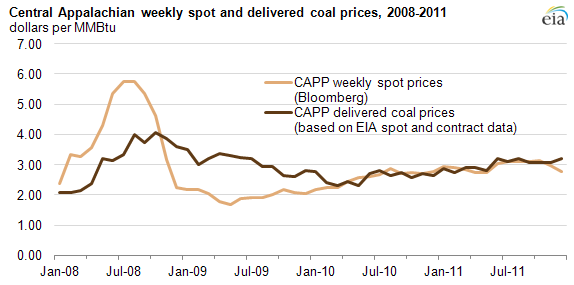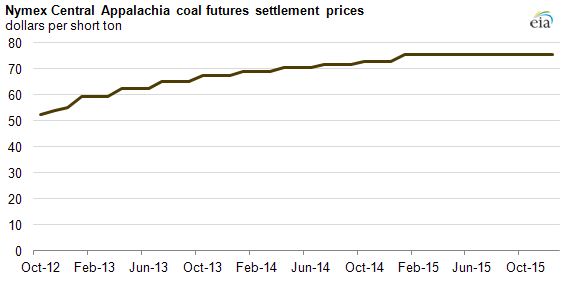
Central Appalachian (CAPP) coal spot prices affect markets for coal and electric power

Note: Bloomberg's data reflect weekly spot prices obtained from brokers in the over-the-counter market for coal. All coal prices assume Free-On-Board Transport (FOB). The FOB price is quoted at the rail or barge point of origin. EIA collects delivered prices to the electric power sector using the EIA-923 survey form. CAPP delivered prices include all costs incurred in the purchase of coal mined in the Central Appalachian basin, and delivery of the fuel to the power plant.
Note: Bloomberg prices for the prompt month have been shifted forward by one month to show the spot versus delivered price for the same month.
Central Appalachian (CAPP) coal spot prices are the most widely referenced prices for eastern coal in the United States. Coal producers, electric utilities, merchant generators, non-utility industrial coal users, and other energy marketers use CAPP spot prices as a benchmark in both physical and financial transactions for short-term and long-term contracts. Changes in CAPP spot prices can affect fuel procurement and power dispatch decisions.
This is the second of two articles on Central Appalachian coal as a key benchmark (or trading point) in the U.S. energy sector. A previous article dealt with the physical location and spot prices of Central Appalachian Coal.
In 2011, the entire CAPP region produced about 185 million short tons, or 17% of total United States coal. However, CAPP spot prices, both for rail and barge, are frequently referenced in coal contracts between coal suppliers and electric power producers.
Coal prices are down from highs set in 2008 (see chart above). Since early 2010, CAPP spot prices for the same delivery month reported by Bloomberg for CSX rail coal and EIA's delivered prices for CAPP coal (drawing upon both spot and contract volumes) have tracked each other more closely.
Some generators use mark-to-market valuations—assessments of the current price for CAPP coal versus the current price for electric power—in making decisions regarding which generating units to dispatch. As part of this assessment, generators will consider spot CAPP prices along with the size of their coal stockpiles.
Most physical CAPP coal sales still occur based on long-term contracts with durations of a year or more. Electric power generators bought just 10.2 million short tons of CAPP coal under short-term contracts in 2011, based on preliminary estimates from EIA. Nonetheless, CAPP spot prices and the forward curve influence negotiations when long-term contracts are signed and therefore affect long-term contract prices.
Beyond the influence of the physical coal market, CAPP spot prices also form the basis for financial contracts for coal, including futures, and influence other risk management mechanisms. Long-term contracts often have "openers" that let counterparties renegotiate delivery prices and other terms. Openers are meant to reduce financial risk from unforeseen changes in market conditions. In this way, traditional contracting has reduced the need for large-volume external financial hedging, often seen in the oil market. However, CAPP spot prices remain a key benchmark when assessing changes in the market.
Along with the physical market for coal—under both long-term and short-term contract durations—CAPP coal is traded in financial markets. For example, the New York Mercantile Exchange (Nymex) provides a futures contract with a physical delivery obligation for Central Appalachian coal (see chart below). This means that sellers are obligated to deliver and buyers are obligated to take possession of CAPP coal per contract specifications unless these parties exit or unwind their futures contract position(s) prior to contract expiration. Currently the Nymex CAPP contracts are traded, for a maximum term of up to five years. Market participants have opportunities to trade other futures contracts or swaps offered by other exchanges or third-party providers. Forward prices like the CAPP futures contract help inform market participants about future power market prices.

Note: Reported as of September 18, 2012.
Tags: coal, electricity, futures, generation, prices, spot prices